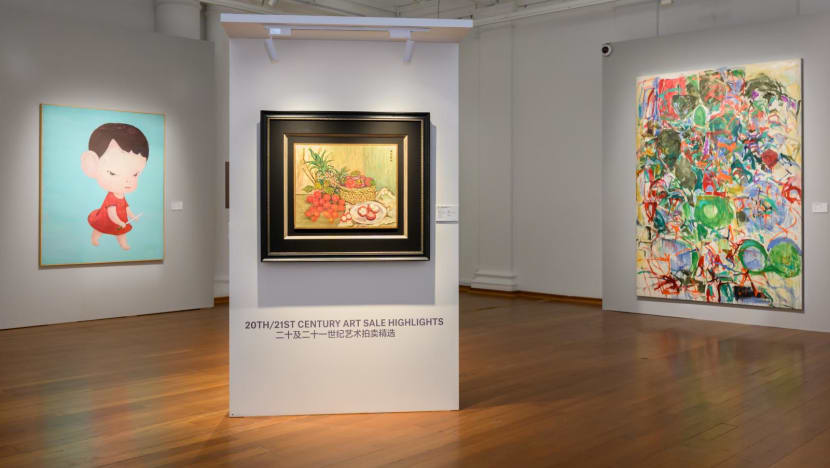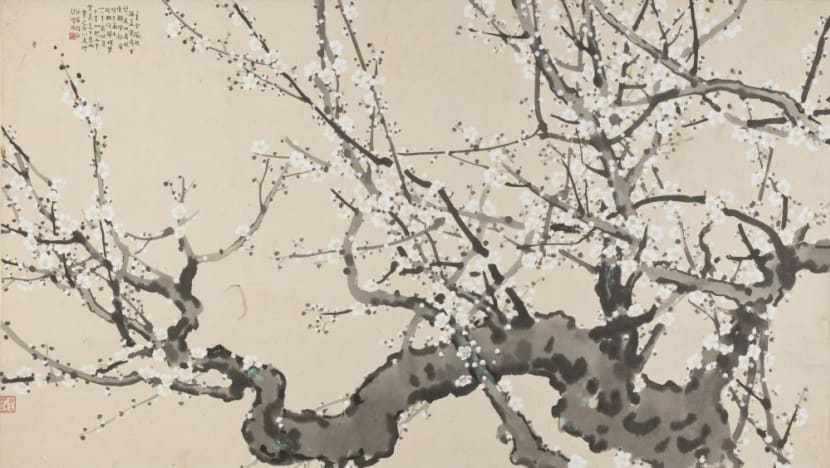Driven by passion and profit, more young Singaporeans buy art
One industry player said his auction house does not advise collectors to buy art purely for investment purposes, and that they need to be motivated by passion.

Christie's preview in Singapore in Oct 2022 at The Art House At The Old Parliament. (Photo: Christie's)
SINGAPORE: When Ms Lee Yi Tian decided to invest in art about three years ago, she was clueless. She was already investing in wine, bonds and stocks but wanted to inject more colour into her portfolio.
“You see so many gorgeous pieces, and you're really spoilt for choice,” the 34-year-old told CNA.
She got in touch with a brokerage firm that shared with her more information, including news articles.
“After a while, certain artists will grow on you. I have my favourites and I started reading up on them,” she said.
She eventually bought works from the three biggest art markets – Asia, Europe and the United States. She rents them out for an income – a guaranteed 6 per cent yield each year.
“It's a good return for something that is worry-free,” she said, adding that property investment, for instance, could be profitable but comes with concerns about maintenance and disrepairs.
Another draw is the bigger payout expected when she sells them.
Art Works Advisory, which helped Ms Lee in her purchases, estimates the value of artwork to rise by 22 per cent every year.
Ms Lee said that investing in art was an easy decision as she has always been interested.
“I'm glad I did it because it's one of the most fun things (I've done) in my investment journey,” she said.
ART AMONG THE YOUNG
Ms Lee is among a growing number of young Singaporeans who are buying art, driven by both passion and profit.
“Our investor base is getting younger … we're starting to see the average age come down from what used to be that 35, 40 age group down to 25 to 35,” said the brokerage’s chief operating officer Chris Hallewell.
Auction house Christie’s has also seen a similar trend. In the first half of 2023, 30 per cent of its Singapore buyers were millennials, compared to 26 per cent in the same period last year.
Their purchases made up 28 per cent of the total Singaporean bought value in the first half of this year, compared to the 8 per cent in the same period last year.
Millennials refer to those born between 1981 and 1996, while those born between 1997 and 2012 are classified as Gen Z.
Christie’s data showed that among Singaporean bought value in the Chinese art works category, 97 per cent was contributed by millennials.
“This can (come) as a surprise, because there's always a preconceived idea that younger collectors would go for contemporary art,” president of Christie’s Asia Pacific Francis Belin told CNA.

"I think it speaks first to the cultural heritage and passion for people's own culture and the passion that they have in rediscovering the continuum of art. You don't see artists today that haven't been inspired by artists from yesterday, who are not inspired from artists from the day before.”
Art Consultancy Metis Art has also seen a rise in millennials purchasing works.
While they do not track the numbers, the firm’s director of education and consultancy Christine Chua said: “The pandemic was a turning point. Without the bustle of office life and constant travel, a lot of millennials became more introspective and curious about art. They also started to notice the empty spaces on their walls at home.”
While auction house Bonhams does not provide data by region, purchases by millennials and Gen Z clients increased by 147 per cent this year.
WHY ARE THEY BUYING ART?
Mr Hallewell said that the interest in art has partly been spurred by the economic situation over the past 18 months.
"We've seen the economic crisis with the stock shares, bonds, real estate volatility … The cost of living increases are having an impact and people are looking for a stable, safe haven investment. So art over the years has been demonstrated to be extremely resilient,” he said.
Ms Chua said that from a financial standpoint, society is in the midst of a “great generational wealth transfer” and art as an alternative asset proves to be a good hedge against inflation.
While Mr Belin from Christie’s acknowledged that it is fair for potential buyers to ask if art costing up to eight figures will yield strong financial returns, his auction house does not advise collectors to buy purely for investment.
“There's so many other things you can do if you really want to invest your money from real estate, stock market, in a financial market, bonds and we think these are more liquid and they are more easily accessible and sometimes even easier to price. We believe that art has to be a passion, collecting has to be a passion,” he said.
Art collection is, however, no cheap affair.
To acquire a valuable art piece, industry players said individuals must be willing to fork out at least between S$10,000 and S$50,000, a steep starting point that may be daunting for some newcomers.
Portfolio expert from Great Eastern Eddy Lim said that in terms of general investments, clients under the age of 35 typically do not invest more than S$3,000 a year, partly due to their limited disposable income.
People in this age group tend to spend their money on things like travel and concert tickets, he said.
“They're still at a stage where they are trying to find out what works,” he added.



















